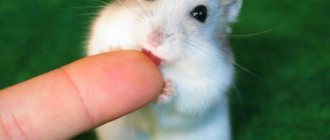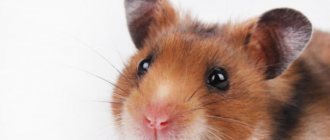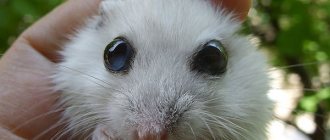Ornamental species of hamsters bred in captivity are very gentle creatures. They are susceptible to various diseases that can arise due to food and water that is stale or treated with substances harmful to the animal, sudden changes in temperature and other things that are less significant for larger animals. If you suddenly find that your beloved hamster is lying down and not moving, do not panic, you need to act quickly and without emotion.
In some cases, it is necessary to provide first aid to your pet before receiving qualified veterinary treatment. After delivering the hamster to the clinic, you need to tell the doctor what preceded this condition and what resuscitation measures were provided.
It is important that before starting any action, you need to analyze the situation: when the changes in the animal’s behavior began, what contributed to this, what symptoms appeared, how long it lasted.
Main causes of heavy breathing
The animal's condition can worsen due to various reasons:
- Pneumonia is the development of inflammatory processes in the lungs. Characterized by wheezing, gurgling and wheezing sounds when breathing. An indicator of the disease is also discharge from the nasal cavity observed over several days. In this case, the hamster becomes inactive, inactive, does not approach the feeder, and drinks little. It becomes difficult for him to breathe, which hinders his movements. The animal simply lies and tries to move less.
- Tumors or metastases in the lungs. Tumors can be benign or malignant (cancerous). Catalysts for their formation can be viruses, a previous infectious disease, decreased immunity, disturbances in the hormonal system, injuries and other reasons. If the tumor begins to spread throughout the body, metastases appear. Their localization may also be in the lungs.
- Poisoning. Intoxication factors: spoiled food or low quality water; eating poisonous plants or grains; ingress of toxic substances into food or water. Signs of poisoning include difficulty breathing, thirst, lethargy, refusal to eat, vomiting, and diarrhea.
- State of agony. If the hamster is breathing heavily and does not move, then this may be an indicator of the pre-mortem stage. Occurs as a result of a serious illness.
Article on the topic: Why does a hamster go bald, what to do if bald spots appear on the back, head or stomach
Heatstroke
I would like to highlight heat stroke in hamsters as a separate point. They are very susceptible to high temperatures and open sun. This is due to the lack of protection against overheating. Signs of heat (sun)stroke:
- the hamster breathes heavily through his mouth;
- the animal looks weakened;
- convulsive syndrome may appear;
- movements become uncoordinated.
With severe overheating, heart failure develops, which leads to death. It can occur either instantly or after a few days, when all organs gradually fail. Heat stroke occurs in the following situations:
- transporting a pet by road during the hot season;
- placing the cage near a window or on a balcony, as well as near radiators or heating devices;
- non-compliance with the optimal microclimate (high temperature and humidity in the room).
In some cases, it is difficult for the owner to understand why his pet is breathing heavily and hardly moving. For example, if he noticed this when the sun was no longer there, or it stopped falling on the cell.
Agony
Due to old age or serious illness, the hamster falls into agony. He may not move for a long time, and then convulsions and depressed breathing occur. In this case, even an experienced specialist will not be able to reverse the animal’s condition.
Did you like the article? Share with friends: [supsystic-social-sharing id=”1"]
- Related Posts
- Tumor in a hamster
- The hamster has a swollen belly
- Cheek pouches in a hamster and their inflammation
« Previous entry
What to do if your hamster begins to breathe heavily?
If you notice such a symptom, contact your veterinarian immediately. For pneumonia, antibacterial drugs are prescribed. Baytril 2.5% is most often used in the form of subcutaneous injections. Course of injections: 1 time daily for 2 weeks.
For sunstroke, the following technique will be used:
- Reduce the temperature. Doing this abruptly, by immersing it in cold water or ice, is strictly prohibited. It is better to place the animal on a cool tile, plate or dampened towel. Then you need to wipe your paws and ears with cool water.
- Prevent dehydration. If the hamster is already unconscious, then he will not be able to drink, but you should not force water in. To perform it correctly, you will need syringes and Ringer's solution or sodium chloride. The dose for a small animal is 2 ml, for larger ones – up to 8 ml.
- Save from shock. If the overheating was too strong, the animal could die at any moment. In this case, it is recommended to perform the angle intramuscularly into the hind leg. The drug is Prednisolone for injection. For small hamsters – 0.05 ml, large – 0.1 ml.
Article on the topic: Rabies in hamsters - one hundred percent fatal, signs and symptoms of the disease
Pet hamsters, although not in good health, can live their entire lives without getting sick. This is achieved by creating optimal conditions and balanced feeding, as well as taking preventive measures. For example, colds can be avoided if you give your pet a chamomile decoction once a week, and also do not leave his cage in a draft.
Thus, keep an eye on your pet, examine it daily, and then it will live a long and rich life. On average, hamsters live for about 3 years (by human standards this is about 25 years), so if he becomes less active, begins to breathe heavily and moves slowly, then just let him live out in peace and do not stress him.
Other diseases
The breathing pattern of a hamster can tell you what kind of illness has overtaken the rodent. So, if a hamster is breathing rapidly without being frightened or exhausted by physical activity, this may indicate that it is suffering from respiratory or heart failure.
Pneumonia
If your hamster's breathing is accompanied by wheezing, gurgling and sniffling, then most likely he has problems with his lungs. If such breathing is accompanied by nasal discharge, lethargy and loss of appetite, then this may indicate that the rodent is suffering from pneumonia. The immobility in this case is explained by the fact that the animal has difficulty breathing, it tries not to move, freezes in place and waits out the attack.
Treatment consists of antibiotic therapy. For small rodents, Baytril 2.5% is usually used, with a dosage of 0.4 ml per 1 kg of weight. For dzhungarik weighing 50 grams, this is 0.01 ml. Injections are given subcutaneously once a day. The course of treatment is 10-14 days.
Agony
If a hamster has felt unwell for several days and after that he lies immobilized, his eyes are open, and his breathing is difficult - he dies. Even an experienced veterinarian is unable to bring a dying animal back to life. The only reasonable solution in this case is to euthanize the rodent to stop its suffering. Hamsters have a very fast metabolism, so a long course of the disease is not typical for them. The animal fades away within a few days.
The hamster lies and does not move
Ornamental species of hamsters bred in captivity are very gentle creatures. They are susceptible to various diseases that can arise due to food and water that is stale or treated with substances harmful to the animal, sudden changes in temperature and other things that are less significant for larger animals. If you suddenly find that your beloved hamster is lying down and not moving, do not panic, you need to act quickly and without emotion.
In some cases, it is necessary to provide first aid to your pet before receiving qualified veterinary treatment. After delivering the hamster to the clinic, you need to tell the doctor what preceded this condition and what resuscitation measures were provided.
It is important that before starting any action, you need to analyze the situation: when the changes in the animal’s behavior began, what contributed to this, what symptoms appeared, how long it lasted.
How is saturation measured?
Saturation is measured with a pulse oximeter. Ambulance teams are equipped with mobile devices. You can also purchase it for home monitoring. The device resembles a clothespin that is attached to your finger.
Within a minute, a sensor with LEDs reads data, namely the color of the blood (hemoglobin), which changes depending on the saturation, as well as a specific pulsating light signal that changes depending on changes in blood pressure.
The pulse oximeter display shows two numbers - the top one shows the percentage of oxygen in the blood, the bottom one shows the pulse.
Saturation is measured in a sitting or lying position, the patient's hand should lie on the surface and not hang in the air.
Hospitals also use invasive devices to help laboratory technicians measure blood gases. To do this, it is taken from an artery or vein.
Reduced ambient temperature
If the animal was healthy and vigorous, and suddenly you noticed that the hamster was lying down and not moving, then first of all you need to assess the temperature. When the air temperature is below 20⁰C for a long time, the rodent can hibernate.
Article on the topic: Colds and runny nose in a hamster: causes and treatment at home
Another reason for deep sleep is a strong reduction in the amount of food - in this case, the animal is starving. Lack of lighting also leads to longer sleep.
If this is really hibernation, then the animal’s body is soft and warm (but lower than usual). Breathing and heartbeat are slow. Therefore, you need to observe the animal for five minutes. To assess the heartbeat, place the thumb and index finger on either side of the hamster's chest under the paws. During hibernation, only four beats can be recorded in one minute.
To wake up a pet, it must be placed in a well-heated room with a temperature of +25⁰C. Prepare clean water in the drinking bowl and food in advance. A healthy animal will wake up on its own in two to three days. It is acceptable to wrap the rodent in a warm blanket or place the cage on bottles of warm water.
There is no need to force events. However, it is necessary to monitor him during this time to see if any odor has appeared or if the body has become numb.
Why does saturation decrease during coronavirus?
Not all patients with COVID-19 have a decrease in saturation, but only with the development of a complication - viral pneumonia. A decrease in saturation indicates probable respiratory failure. If a coronavirus infection has penetrated the lung tissue, and a person’s immune system cannot cope with it, a destructive process begins in the lungs - the alveolar septa (and interstitium) are damaged and inflamed, and the alveoli themselves are filled with liquid exudate - normally they are filled with air and are the starting point of transportation oxygen to organs, including the heart and brain. Since there is no damage to the bronchial tree with coronavirus, a decrease in saturation in a patient may indicate a reduction in the functional areas of the lung tissue.
If coronavirus saturation is below 95%, the patient may be hospitalized.
Increased ambient temperature
Small rodents, despite the fact that in the wild they can live in steppes, deserts and semi-deserts, do not tolerate heat well.
Prolonged exposure to high temperatures can lead to heat stroke.
Signs of this condition will be:
- Trembling when touched
- Convulsions
- Weakness and indifference
- Coordination of movements is impaired
- The hamster lies on its side and breathes heavily
Sudden overheating can lead to heart failure, which can be fatal. Such rodents do not have the body's natural protective functions in the form of sweat or mouth breathing.
If the animal is lethargic, but the exposure to high temperatures has not been for a long time, then the first aid will be to move it to a cooler room and spray cold water over it from a spray bottle.
Article on the topic: Why does a hamster itch and bite itself, what to do?
A quick way to cool the body is to place the animal under a stream of cold water, holding the muzzle so that the hamster does not choke.
If the animal begins to come to life, it is important to give it water using a syringe or pipette.
In an unconscious state, the rodent will not be able to swallow liquid. To replenish the water-salt balance, a solution of sodium chloride or ringer is injected subcutaneously. Large breeds can be injected from four to eight milliliters, dwarf and Djungarian hamsters - two milliliters.
In an emergency, when veterinary care cannot be obtained, prednisolone is injected intramuscularly into the hind leg using an insulin syringe.
For a Syrian hamster, the dose is 0.1 ml, for a Djungarian hamster - half as much.
Why can pulse oximetry data be misleading?
It is important to understand that the result of pulse oximetry can be influenced by: the sensitivity of the device (including battery charge), lighting, and the color of the patient’s skin (the darker, the higher the indicator, which does not reflect the real state of affairs).
The concept of “saturation rate” is very arbitrary. It happens that patients with signs of coronavirus infection and a mobile non-invasive device for measuring saturation begin to panic and call an ambulance if the oxygen in the blood drops, for example, to 93%. To do this, let’s look at the data from the conditional norm table:
Temperature-related disorders
If the hamster did not show the slightest signs of illness and suddenly fell into an unconscious state, it may be hibernating. In the natural environment, Djunga hamsters retire in winter, experiencing cold weather, periods of lack of food and insufficient lighting. The other extreme is overheating of the hamster, and this is much more dangerous than cooling, since the small animal is absolutely defenseless against high thermometer readings. It is overheating that most often becomes the cause of death for a rodent.
Article on the topic: The hamster has a swollen belly: what does it mean and what to do
Low room temperature
Turning off the heating or leaving a window open for a long time on a frosty day can cause the hamster to fall into torpor. In this case, the body will be very cold, and the heartbeat will slow down significantly - to one beat every fifteen seconds. A sleeping hamster barely breathes and due to its small size it is quite difficult to determine how intense the breathing is and whether it exists at all. But if the body is soft to the touch, this means that the rodent is alive.
To awaken it, you need to move the cage to a room with a temperature above +20 degrees. The hamster will wake up in 2-3 days and care should be taken that the feeder and water bowl are full when he wakes up. This is especially important, since during hibernation a rodent wastes a very large amount of energy and its health will depend on how quickly it replenishes it with food. A hamster left hungry after hibernation may develop serious liver problems.
This method of awakening is optimal, since it is close to how a hamster wakes up from hibernation in its natural environment, but the process can be accelerated:
- Wrap the hamster in a warm cloth or down mitten, place it in a cage and move it to a room with a high temperature.
- Fill several bottles with hot water, place them in a row and place the cage on them. Heat will be transferred through the bottom, warming the hamster
Important! Try not to let your hamster hibernate again. To do this, you need to maintain the temperature in the room where the cage is above +20 degrees, make sure that a sufficient amount of sunlight penetrates into the hamster’s house, and that the rodent always has the necessary amount of food and drink.
Article on the topic: The hamster's hind legs failed: causes and treatment
Symptoms of the disease
The most important symptom of diseases of the visual organ of all hamsters is the appearance of cloudy white or grayish discharge from the eye. In this case, the eyelids of rodents are stuck together, wet, half-open, or close the eye completely. Your pet refuses food, and sometimes even water, runs very little, and spends a lot of time sleeping. Knowing that furry rodents often carry infections into the eyes, their owners are haunted by questions related to the eye health of their charges:
Why doesn't my animal's eyes open? The reason for this may be an ordinary draft. Have you decided to ventilate your apartment without protecting your pet from cold air and dampness? So you end up with a problem with your pet’s eyes. Hamsters have a hard time withstanding dampness and wind. The second most common cause is eye injury; if the injury is accompanied by active scratching of the rodent's organ of vision, then most likely your pet has unilateral conjunctivitis.
Let's highlight the main reasons why a hamster does not open its eyes:
- allergic reaction to both food products and surrounding objects (litter, dust, tree bark, tree branches);
- acute conjunctivitis;
- some serious internal disease of the animal;
- advanced age of the hamster.
What to do if a rodent's eye turns sour or festeres.
Suppuration of the eyes in hamsters occurs due to the fact that microorganisms enter the mucous membrane, causing all kinds of pathologies (diseases) of the eye.
With an infectious disease - conjunctivitis, the animal's eyelids stick together, the animal opens its eyes with difficulty, and often rubs its muzzle with its paws. The hamster eats without appetite, and sometimes even refuses to eat, spends a lot of time sleeping, and tries to hide from the light.
Sometimes there are cases: violations of asymmetry on the muzzle or protrusion of the eyeball outward; if the eye is injured, it can simply fall out. Eye loss is called eyeball prolapse. This disease occurs with suppuration, and if not treated in a timely manner, the animal can not only lose its visual organ, but also die.
Correct content
First, let's look at how to properly keep a hamster, because poor living conditions can cause death.
If you want to create ideal living conditions for your pet, you should not seek advice from sellers and consultants at pet stores. Often these people do not have specialized training and are interested in getting as much money as possible for goods, even if in the end they may cost your pet's life.
To keep your hamster healthy, it is important to choose the right cage. A high cage is dangerous, as hamsters like to climb up the bars under the roof and fall from there, seriously injuring themselves.
The cage should be spacious. Minimum bottom dimensions:
- for dwarf species - 50*30 cm;
- for Syrian hamsters - 60*40 cm.
The minimum size means that it is advisable to take a larger cage along the bottom, but not smaller.
Equally important is a running wheel of the correct size:
- for a dwarf hamster, the wheel diameter is from 16 cm;
- for a Syrian hamster - from 18 cm.
You shouldn’t take two hamsters with the motivation “so that one doesn’t get bored.” Hamsters are territorial animals. There is a high probability that one day, instead of two pets getting along, you will see a bloody battle with a fatal outcome. This applies to both different-sex and same-sex hamsters.
Do not engage in uncontrolled breeding of hamsters. Pregnancy seriously shortens the life of the female, and in some cases can lead to the death of her and her babies. Hamsters are famous for the fact that they can easily eat their offspring.
Hamsters should not be bathed in water. They need special sand for bathing.











